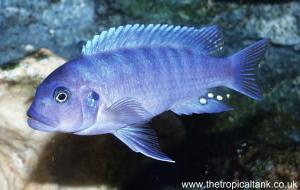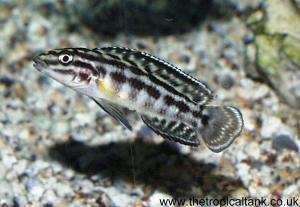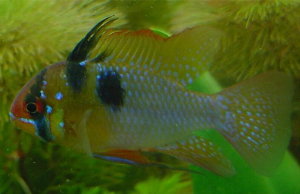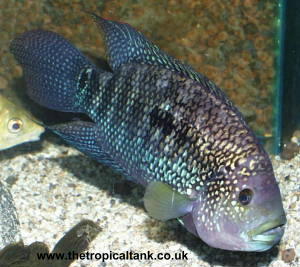

Photos taken at Wharf Aquatics
© Sean Evans
|
| Common name: | (none) |
| Scientific name: | Pelvicachromis signatus |
| Synonyms: | (none) |
| Size: | Up to 4" (10cm), female smaller. |
| Origin: | West Africa: Guinea, Kolente region. |
| Tank setup: | A lightly planted tank, with caves formed by rocks or bogwood, or artificial alternatives. Lighting should not be overly bright, so plants that
do well in lower light levels are ideal, such as Anubias, Cryptocoryne and Java Fern.
A substrate of fine gravel or aquarium sand is ideal. |
| Compatibility: | More peaceful than larger cichlids, but they will become territorial when spawning. They can usually be safely included in
medium-large community tank without problems as long as they have room for territories. |
| Temperature: | 24-28oC (75-82oF) |
| Water chemistry: | Soft water with a neutral or slightly acidic pH is ideal. |
| Feeding: | Omnivorous: feed a variety of dry foods, including some veggie based foods, as these cichlids feed on detritus and algae in the wild as well as
small insect larvae. Frozen foods such as bloodworm, brine shrimp, mysis and mosquito larvae can be used to supplement the dry foods. |
| Sexing: | Males are larger with a slender shape and more elongated dorsal and anal fins. The smaller female has a purple belly region. |
| Breeding: | Cave spawner, provide caves with a very small entrance. Caves made from resin or broken plant pots work well, but caves formed by bogwood
will also be used. The female usually guards the eggs and larval stage, while the male defends the territory. Fry are normally free-swimming in about 8-10 days. At this time, both parents normally tend the fry.
This broodcare may last several weeks. |
| Comments: |
This species was described relatively recently, in 2004.
|









